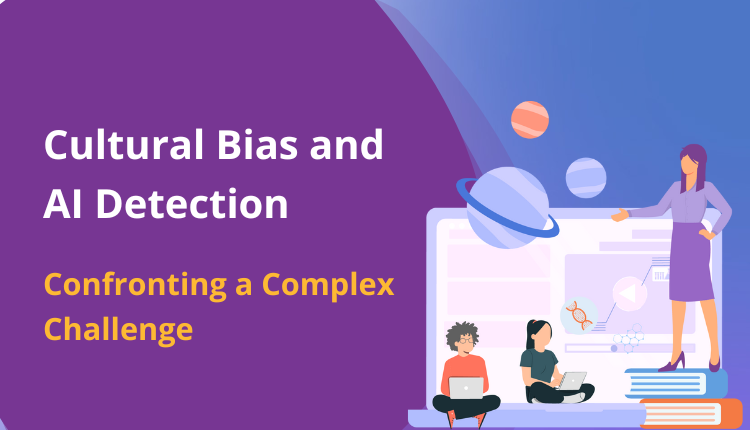Artificial intelligence (AI) has significantly transformed industries like education, healthcare, recruitment, and research by automating processes and offering innovative solutions. However, despite AI’s potential for neutrality, a critical issue persists cultural bias. This challenge arises when AI systems unintentionally favor or disadvantage certain groups due to the sociocultural, linguistic, or contextual biases embedded in their data, design, and algorithms.
In this blog, we’ll break down the sources of cultural bias in AI, explore its impact on academia and professional spheres, and discuss how ethical AI solutions, such as Trinka, can help address these issues.
Understanding Cultural Bias in AI
Cultural bias in AI refers to skewed or unfair outcomes resulting from the unequal representation of diverse linguistic, cultural, or sociopolitical nuances in the datasets utilized to train AI models. While AI strives to be objective and data-driven, the data itself is often collected in contexts that favor certain customs, norms, or languages, inadvertently embedding bias.
For instance, some AI grammar checkers, or plagiarism detectors may unfairly penalize non-Western writing structures due to a lack of adequate exposure to diverse linguistic norms. Similarly, facial recognition systems have historically struggled with accurate identification of darker-skinned individuals because of the bias in their training datasets.
How Cultural Bias Creeps Into AI: Data Challenges
AI tools like grammar checkers, AI content detectors, and recommendation engines rely heavily on algorithms trained on large datasets. When these datasets disproportionately represent one cultural or linguistic group, the system effectively becomes tailored to their patterns, leaving other groups at risk of marginalization. Here’s how cultural bias emerges:
1. Representation Bias
Datasets primarily comprising English-speaking or Western narratives struggle to recognize non-English languages and regional genre variations. For example, AI might reject certain regional idioms or transliterations as incorrect when they are linguistically sound in their context.
2. Historical Bias
Historic societal inequities, such as gender or racial discrimination, often surface in datasets. For example, AI recruitment tools have been known to favor male candidates based on biased hiring data from the past.
3. Measurement Errors
When evaluation criteria are culturally specific (e.g., readability tests favoring Western phrasing), diverse formats often result in lower scores or are deemed invalid, even if contextually aligned.
Such systemic bias further propagates existing inequalities, leading to significant hurdles in education, hiring, and global communications.
Real-World Implications of Cultural Bias in AI Detection
When cultural bias infiltrates AI, its impact extends beyond technical errors, seeping deeply into academic, workplace, and social interactions. Here are some key examples:
1. Challenges for English-Language Learners (ELLs)
English learners often encounter higher rates of false accusation for plagiarized or machine-generated work. Rigid algorithms misjudge their phrasing or sentence structures, labeling them unusual.
2. Barriers in Academia
Misaligned detection metrics may flag diverse writing styles used by students and researchers, creating unnecessary barriers for well-researched papers outside of Western academic standards.
3. Workplace Inequality
AI hiring platforms may inadvertently perpetuate biases against marginalized groups or undervalue unique communication styles essential in global workplaces.
These biases erode trust in AI systems, undermining the inclusive environments they aim to achieve.
Ethical AI Design: A Path to Reducing Bias
Designing ethical AI frameworks is imperative to ensure fairness and neutrality. Here are practical methods to address cultural bias in AI:
1. Diverse and Inclusive Data Training
AI datasets must represent multiple cultures, languages, and backgrounds to ensure inclusivity. For example, incorporating multilingual corpora into grammar checkers improves global linguistic relevance.
2. Transparent Algorithms
Clear documentation of AI processes, limitations, and assumptions can preempt cultural exclusions and biases.
3. Contextual Customization
AI tools should support user-driven adjustments. For instance, language detectors capable of toggling between American, British, or Indian English capture linguistic variability, respecting global contexts.
Tackling Bias with Trinka: Inclusive AI Solutions
As an ethical AI-powered tool for writing and research, Trinka AI exemplifies a proactive stance against cultural bias by prioritizing fairness and accuracy. Here’s how it achieves inclusivity:
1. Linguistic Versatility
Trinka recognizes various English variations, such as British, American, and Australian English, ensuring global linguistic nuances are seamlessly integrated.
2. Contextual Relevance
Trinka provides suggestions tailored to specific scenarios, avoiding over-simplification or penalization of non-standard conventions.
3. User Personalization
Through domain customization, Trinka optimizes its tool for professional, academic, or creative writing needs, significantly reducing chances of cultural misinterpretations.
By leveraging ethical AI design, Trinka bridges cultural gaps, empowering researchers, students, and professionals worldwide to deliver their best work without fear of misjudgment.
Practical Tips for Using AI Ethically
Here’s how researchers and professionals can ensure unbiased AI practices in their workflows:
- Choose Tools Committed to Ethical Practices: opt for AI platforms like Trinka that emphasize inclusivity through diverse datasets and customizable features.
- Critically Evaluate AI Outputs: Always review AI suggestions to align them with your context, especially for specialized or regional texts.
- Contribute Feedback: Report culturally insensitive or limiting behavior in AI tools. User insights are essential for evolutionary improvements.
- Encourage Transparent Authorship Tools: Use tools like Trinka’s plagiarism detection to verify citations and avoid machine-dependent edits that dilute originality.
Exploring Ethical AI: Fostering Global Inclusivity with Trinka
While cultural variation enriches creative and professional expressions, AI systems must support—not limit—diversity. Building ethical frameworks requires collaboration among engineers, linguists, and anthropologists and setting user-centric goals for AI development.
With solutions like Trinka AI content detector, the future of inclusive, fair writing support is already within grasp. Whether you are drafting an academic paper, refining professional documents, or creating expressive content that resonates globally—Trinka ensures your work aligns seamlessly with any cultural or linguistic standard.
Ready to redefine you’re writing with ethical, inclusive AI?
Visit Trinka’s advanced features and experience the difference today. Maximize your content’s value while fostering global diversity through seamless functionality.

